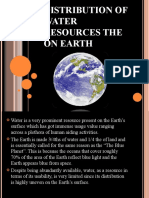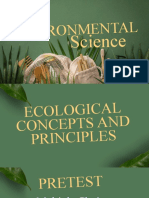Environmental Science
Environmental Science
Uploaded by
ilyaskureshiCopyright:
Available Formats
Environmental Science
Environmental Science
Uploaded by
ilyaskureshiOriginal Description:
Copyright
Available Formats
Share this document
Did you find this document useful?
Is this content inappropriate?
Copyright:
Available Formats
Environmental Science
Environmental Science
Uploaded by
ilyaskureshiCopyright:
Available Formats
CHAPTER
1
INTRODUCTION
Environmental Science : Definition, Scope and Importance
The science of Environment studies is a multi-disciplinary science because it comprises various branches of studies like chemistry, physics, medical science, life science, agriculture, public health, sanitary engineering etc. It is the science of physical phenomena in the environment. It studies of the sources, reactions, transport, effect and fate of physical a biological species in the air, water and soil and the effect of from human activity upon these.
Environment Explained
Literary environment means the surrounding external conditions influencing development or growth of people, animal or plants; living or working conditions etc. This involves three questions:
1. What is Surrounded
The answer to this question is living objects in general and man in particular.
2. By what Surrounded
The physical attributes are the answer to this question, which become environment. In fact, the concern of all education is the environment of man. However, man cannot exist or be understood in isolation from the other forms of life and from plant life. Hence, environment refers to the sum total of condition, which surround point in space and time. The scope of the term Environment has been changing and widening by the passage of time. In the primitive age, the environment consisted of only physical aspects of the planted earth' land, air and water as biological communities. As the time passed on man extended his environment through his social, economic and political functions.
3. Where Surrounded
The answer to this question. It is in nature that physical component of the plant earth, viz land, air, water etc., support and affect life in the biosphere. According to a Goudie
1
ENVIRONMENTAL SCIENCE
environment is the representative of physical components of the earth where in man is an important factor affecting the environment. (i) Definitions of Environment : Some important definitions of environment are as under: 1. Boring: A persons environment consists of the sum total of the stimulation which he receives from his conception until his death. It can be concluded from the above definition that Environment comprises various types of forces such as physical, intellectual, economic, political, cultural, social, moral and emotional. Environment is the sum total of all the external forces, influences and conditions, which affect the life, nature, behaviour and the growth, development and maturation of living organisms. 2. Douglas and Holland: The term environment is used to describe, in the aggregate, all the external forces, influences and conditions, which affect the life, nature, behaviour and the growth, development and maturity of living organisms. (ii) Scope of Environment: The environment consists of four segments as under: 1. Atmosphere: The atmosphere implies the protective blanket of gases, surrounding the earth: (a) It sustains life on the earth. (b) It saves it from the hostile environment of outer space. (c) It absorbs most of the cosmic rays from outer space and a major portion of the electromagnetic radiation from the sun. (d) It transmits only here ultraviolet, visible, near infrared radiation (300 to 2500 nm) and radio waves. (0.14 to 40 m) while filtering out tissue-damaging ultraviolate waves below about 300 nm. The atmosphere is composed of nitrogen and oxygen. Besides, argon, carbon dioxide, and trace gases. 2. Hydrosphere: The Hydrosphere comprises all types of water resources oceans, seas, lakes, rivers, streams, reserviour, polar icecaps, glaciers, and ground water. (i) Nature 97% of the earths water supply is in the oceans, (ii) About 2% of the water resources is locked in the polar icecaps and glaciers. (iii)Only about 1% is available as fresh surface water-rivers, lakes streams, and ground water fit to be used for human consumption and other uses. 3. Lithosphere: Lithosphere is the outer mantle of the solid earth. It consists of minerals occurring in the earths crusts and the soil e.g. minerals, organic matter, air and water. 4. Biosphere: Biosphere indicates the realm of living organisms and their interactions with environment, viz atmosphere, hydrosphere and lithosphere.
ENVIRONMENTAL SCIENCE : DEFINITION, SCOPE AND IMPORTANCE
Element of Environment
Environment is constituted by the interacting systems of physical, biological and cultural elements inter-related in various ways, individually as well as collectively. These elements may be explained as under:
(1) Physical elements
Physical elements are as space, landforms, water bodies, climate soils, rocks and minerals. They determine the variable character of the human habitat, its opportunities as well as limitations.
(2) Biological elements
Biological elements such as plants, animals, microorganisms and men constitute the biosphere.
(3) Cultural elements
Cultural elements such as economic, social and political elements are essentially manmade features, which make cultural milieu.
ENVIRONMENT STUDIES: IMPORTANCE
Importance of Environment Studies: The environment studies enlighten us, about the importance of protection and conservation of our indiscriminate release of pollution into the environment. At day by besides become present a great number of environment issues, have grown in size and complexity day, threatening the survival of mankind on earth. We study about these issues and effective suggestions in the Environment Studies. Environment studies have significant for the following reasons:
1. Environment Issues Being of International Importance
It has been well recognised that environment issues like global warming and ozone depletion, acid rain, marine pollution and biodiversity are not merely national issues but are global issues and hence must be tackled with international efforts and cooperation.
2. Problems Cropped in The Wake of Development
Development, in its wake gave birth to Urbanization, Industrial Growth, Transportation Systems, Agriculture and Housing etc. However, it has become phased out in the developed world. The North, to cleanse their own environment has, fact fully, managed to move dirty factories of South. When the West developed, it did so perhaps in ignorance of the environmental impact of its activities. Evidently such a path is neither practicable nor desirable, even if developing world follows that.
3. Explosively Increase in Pollution
World census reflects that one in every seven persons in this planted lives in India. Evidently with 16 per cent of the world's population and only 2.4 per cent of its land area, there is a heavy pressure on the natural resources including land. Agricultural experts have recognized soils health problems like deficiency of micronutrients and organic matter, soil salinity and damage of soil structure.
ENVIRONMENTAL SCIENCE
4. Need for An Alternative Solution
It is essential, specially for developing countries to find alternative paths to an alternative goal. We need a goal as under: (1) A goal, which ultimately is the true goal of development an environmentally sound and sustainable development. (2) A goal common to all citizens of our earth. (3) A goal distant from the developing world in the manner it is from the over-consuming wasteful societies of the developed world.
5. Need To Save Humanity From Extinction
It is incumbent upon us to save the humanity from exinction. Consequent to our activities constricting the environment and depleting the biosphere, in the name of development.
6. Need For Wise Planning of Development
Our survival and sustenance depend. Resources withdraw, processing and use of the product have all to by synchronised with the ecological cycles in any plan of development our actions should be planned ecologically for the sustenance of the environment and development.
7. Misras Report
Misra (1991) recognized four basic principles of ecology, as under: (i) Holism (ii) Ecosystem (iii) Succession (iv) Conversation. Holism has been considered as the real base of ecology. In hierarchical levels at which interacting units of ecology are discussed, are as under: Individual<population<community<ecosystem<biome<biosphere. Misra (1991) has recognised four basic requirements of environmental management as under: (i) Impact of human activities on the environment, (ii) Value system, (iii) Plan and design for sustainable development, (iv) Environment education. Keeping in view the of goal of planning for environmentally sustainable development India contributed to the United Nations Conference on Environment and Development (UNCED), also referred to as Earth Summit held at Rio de Janciro, the Capital of Brazil, 3rd-14th June, 1992.
NEED FOR PUBLIC AWARENESS
It is essential to make the public aware of the formidable consequences of the Environmental Degradation, if not retorted and reformative measures undertaken, would
ENVIRONMENTAL SCIENCE : DEFINITION, SCOPE AND IMPORTANCE
result in the extinction of life. We are facing various environmental challenges. It is essential to get the country acquainted with these challenges so that their acts may be eco-friendly. Some of these challenges are as under:
1. Growing Population
A population of over thousands of millions is growing at 2.11 per cent every year. Over 17 million people are added each year. It puts considerable pressure on its natural resources and reduces the gains of development. Hence, the greatest challenge before us is to limit the population growth. Although population control does automatically lead to development, yet the development leads to a decrease in population growth rates. For this development of the women is essential.
2. Poverty
India has often been described a rich land with poor people. The poverty and environmental degradation have a nexus between them. The vast majority of our people are directly dependent on the nature resources of the country for their basic needs of food, fuel shelter and fodder. About 40% of our people are still below the poverty line. Environment degradation has adversely affected the poor who depend upon the resources of their immediate surroundings. Thus, the challenge of poverty and the challenge environment degradation are two facets of the same challenge. The population growth is essentially a function of poverty. Because, to the very poor, every child is an earner and helper and global concerns have little relevance for him.
3. Agricultural Growth
The people must be acquainted with the methods to sustain and increase agricultural growth with damaging the environment. High yielding varities have caused soil salinity and damage to physical structure of soil.
4. Need to Ground water
It is essential of rationalizing the use of groundwater. Factors like community wastes, industrial effluents and chemical fertilizers and pesticides have polluted our surface water and affected quality of the groundwater. It is essential to restore the water quality of our rivers and other water bodies as lakes is an important challenge. It so finding our suitable strategies for consecration of water, provision of safe drinking water and keeping water bodies clean which are difficult challenges is essential.
5. Development And Forests
Forests serve catchments for the rivers. With increasing demand of water, plan to harness the mighty river through large irrigation projects were made. Certainly, these would submerge forests; displace local people, damage flora and fauna. As such, the dams on the river Narmada, Bhagirathi and elsewhere have become areas of political and scientific debate. Forests in India have been shrinking for several centuries owing to pressures of agriculture and other uses. Vast areas that were once green, stand today as wastelands. These areas are to be brought back under vegetative cover. The tribal communities inhabiting forests respects the trees and birds and animal that gives them sustenance. We must recognise
ENVIRONMENTAL SCIENCE
the role of these people in restoring and conserving forests. The modern knowledge and skills of the forest deptt. should be integrated with the traditional knowledge and experience of the local communities. The strategies for the joint management of forests should be evolved in a well planned way.
6. Degradation of Land
At present out of the total 329 mha of land, only 266 mha possess any potential for production. Of this, 143 mha is agricultural land nearly and 85 suffers from varying degrees of soil degradation. Of the remaining 123 mha, 40 are completely unproductive. The remaining 83 mha is classified as forest land, of which over half is denuded to various degrees. Nearly 406 million head of livestock have to be supported on 13 mha, or less than 4 per cent of the land classified as pasture land, most of which is overgrazed. Thus, our of 226 mha, about 175 mha or 66 per cent is degraded to varying degrees. Water and wind erosion causes further degradation of almost 150 mha This degradation is to be avoided.
7. Reorientation of Institutions
The people should be roused to orient institutions, attitudes and infrastructures, to suit conditions and needs today. The change has to be brought in keeping in view Indias traditions for resources use managements and education etc. Change should be brought in education, in attitudes, in administrative procedures and in institutions. Because it affects way people view technology resources and development.
8. Reduction of Genetic Diversity
Proper measures to conserve genetic diversity need to be taken. At present most wild genetic stocks have been disappearing from nature. Wilding including the Asiatic Lion are facing problem of loss of genetic diversity. The protected areas network like sanctuaries, national parks, biosphere reserves are isolating populations. So, they are decreasing changes of one group breeding with another. Remedial steps are to be taken to check decreasing genetic diversity.
9. Evil Consequences of Urbanisation
Nearly 27 per cent Indians live in urban areas. Urbanisation and industrialisation has given birth to a great number of environmental problem that need urgent attention. Over 30 percent of urban Indians live in slums. Out of Indias 3,245 towns and cities, only 21 have partial or full sewerage and treatment facilities. Hence, coping with rapid urbanization is a major challenge.
10. Air and water Population
Majority of our industrial plants are using outdated and population technologies and makeshift facilities devoid of any provision of treating their wastes. A great number of cities and industrial areas that have been identified as the worst in terms of air and water pollution. Acts are enforced in the country, but their implement is not so easy. The reason is their implementation needs great resources, technical expertise, political and social will. Again the people are to be made aware of these rules. Their support is indispensable to implement these rules.
ENVIRONMENTAL SCIENCE : DEFINITION, SCOPE AND IMPORTANCE
VARIOUS TYPES OF ENVIRONMENT
According to Kurt Lewin, environment is of three types which influence the personality of an individual as under: (a) Physical Environment, (b) Social and Cultural Environment, and (c) Psychological Environment. These may be explained as under:
1. Physical Environment
Physical environment, refers to geographical climate and weather or physical conditions wherein and individual lives. The human races are greatly influenced by the climate. Some examples are as under: (a) In the cold countries i.e. European countries the people are of white colour. Likewise, in Asian and African countries, that is, in hot countries people are of dark complexion. (b) The physique of an individual depends on climate conditions as the individual tries to adjust in his physical environment. (d) The human working efficiency also depends on the climatic conditions.
2. Social Environment
Social Environment includes an individuals social, economic and political condition wherein he lives. The moral, cultural and emotional forces influence the life and nature of individual behaviour. Society may be classified into two categories as under: (i) An open society is very conductive for the individual developement. (ii) A closed society is not very conductive for the developenment.
3. Psychological Environment
Although physical and social environment are common to the individual in a specific situation. Yet every individual has his own psychological environment, in which he lives. Kurt Lewin has used the term life space for explaining psychological environment. The Psychological environment enables us to understand the personality of an individual. Boththe person and his goal form psychological environment. If a person is unable to overcome the barriers, he can either get frustrated or completed to change his goal for a new psychological environment. But adopting this mechanism, the individual is helped in his adjustment to the environment.
STRUCTURE OF ENVIRONMENT
Environment is both physical and biological. It includes both living and non-living components.
(i) Physical Environment
The Physical Environment is classified into three broad categories viz.
ENVIRONMENTAL SCIENCE
(i) Solid, (ii) Liquid (iii) Gas. These represent the following spheres: (i) The lithosphere (solid earth) (ii) The hydrosphere (water component) and (iii) The atmosphere As such, the three basic of physical environment may be termed as under: (i) Lithospheric Environment (ii) Hydrospheric Environment (iii) Atmospheric Environment The scientists have classified them into smaller units based on different spatial scales, e.g. (i) Mountain Environment (ii) Glacier Environment (iii) Plateau Environment (iv) Coastal Environment
(ii) Biological Environment
The biological of the environment consists of: (i) Plants (flora) (ii) Animals (fauna). Thus, the biotic environment further be divided into floral environment and faunal environment. All the organisms work to form their social groups and organizations at several levels. Thus, the social environment is formed. In this social environment the organisms work to derive matter from the physical environment for their sustenance and development. This process gives birth to economic environment. Man claims to be most skilled and civilized of all the organisms. This is the reason why his social organisation is most systematic. The three aspects of man, e.g. physical, social and economic, function in the biotic environment as under:
(i) The Physical Man
The Physical Man is one of the organisms populations or biological community. He is in need of basic elements of the physical environment like habitat (space), air, water and food. Besides, like other biological populations, he releases wastes into the ecosystem.
(ii) The Social Man
The Social Man performs the following functions: (a) Establishing social institutions, (b) Forming social organisations,
ENVIRONMENTAL SCIENCE : DEFINITION, SCOPE AND IMPORTANCE
(c) Formulating laws, principles and policies, (d) Taking steps to safeguard his existence, interest and social welfare.
(iii) The Economic Man
The economic man derives and utilises resources from the physical and biotic environment with his skills and technologies. The economic function makes the man an environment/ geomorphic process as he transports matter and energy from one component of the ecosystem to the other. There may be any following two situations: (a) His exploitative functions may be in harmony with the natural environment. Such, functions do not necessarily involve change in the working of the ecosystem. (b) These functions may exceed the critical limit. Consequently, the equilibrium of the environment/ecosystem is disturbed and a great number of environment and ecological problems crop up. These are determental to man him besides to whole population of human species in a given ecosystem.
QUESTIONS
1. What is Environment? Discuss the scope of Environment. 2. Describe the importance of environment studies. 3. The need for public awareness about environment is of vital importance. Discuss. 4. Discuss the various types of environment.
Short Answer Type Questions
1. Define environments. 2. Discuss the scope of environment. 3. Write a note on the importance of environment studies. 4. Write a note on the need of public awareness about environment. 5. Write a note on physical environment. 6. Write a note on biological environment.
You might also like
- Module 2 - Overview and Intro 2 Env SciDocument15 pagesModule 2 - Overview and Intro 2 Env SciA. MagnoNo ratings yet
- Lesson 4 Philippine Forest and Wildlife Resources: By: For. Leslie Sanchez Obiso CTU-BariliDocument12 pagesLesson 4 Philippine Forest and Wildlife Resources: By: For. Leslie Sanchez Obiso CTU-BariliLeslie ObisoNo ratings yet
- Leaf ChromatographyDocument8 pagesLeaf Chromatographyms_atieNo ratings yet
- Abiotic Vs Biotic Factors WorksheetDocument2 pagesAbiotic Vs Biotic Factors WorksheetJesseNo ratings yet
- 840D AupDocument342 pages840D AupilyaskureshiNo ratings yet
- Ge 10-Midterm Examination - EditedDocument6 pagesGe 10-Midterm Examination - EditedAlfred TorgaNo ratings yet
- Week 2 Basic Concepts and Principles in Ecology and Environmental ScienceDocument33 pagesWeek 2 Basic Concepts and Principles in Ecology and Environmental SciencejamaellajaneNo ratings yet
- Distribution of Water On EarthDocument16 pagesDistribution of Water On EarthKaizen Shori100% (1)
- Prelims Envi SciDocument5 pagesPrelims Envi SciCyndi SamaniegoNo ratings yet
- Composition and Layers of The Atmosphere Report AprilDianeGDocument22 pagesComposition and Layers of The Atmosphere Report AprilDianeGPatricia Sofia DizonNo ratings yet
- Biodiversity PDFDocument78 pagesBiodiversity PDFRaymond LuberiaNo ratings yet
- Wildlife Reviewer 2017Document51 pagesWildlife Reviewer 2017Vohn Archie EdjanNo ratings yet
- Kathryn Abasolo Performance Task in General Chemistry 2 Docx StudentsDocument10 pagesKathryn Abasolo Performance Task in General Chemistry 2 Docx StudentskathrynNo ratings yet
- Environmental Quiz 4Document4 pagesEnvironmental Quiz 4Isaiah Peligrino50% (2)
- Environmental ScienceDocument25 pagesEnvironmental ScienceJennica AntiqueraNo ratings yet
- Introduction To Environmental ScienceDocument23 pagesIntroduction To Environmental Sciencejuvy perezNo ratings yet
- Wildlife Reviewer 2016 YES-ODocument22 pagesWildlife Reviewer 2016 YES-OVohn Archie EdjanNo ratings yet
- Environmental Science: 1St Generation Modules - Version 2.0Document34 pagesEnvironmental Science: 1St Generation Modules - Version 2.0JimNo ratings yet
- Ecological Principles and Concepts ScriptDocument10 pagesEcological Principles and Concepts ScriptJaffy Bustamante0% (1)
- 2nd Exam Envisci7 2022Document5 pages2nd Exam Envisci7 2022Liezl ValienteNo ratings yet
- Science Club Project ProposalDocument6 pagesScience Club Project Proposalprecious.grace0619100% (1)
- Human Activities and Their Impact On The EnvironmentDocument58 pagesHuman Activities and Their Impact On The Environmentrorlando lewis100% (1)
- Module 6: Environmental Resource Protection and Management: Week 9Document38 pagesModule 6: Environmental Resource Protection and Management: Week 9Alyssa Joanna LlorinNo ratings yet
- Natural Resources Presentation RubricDocument2 pagesNatural Resources Presentation Rubricjuanitacastro_07No ratings yet
- Concentration of Solutions - Print - QuizizzDocument5 pagesConcentration of Solutions - Print - QuizizzDarmaine Pajares100% (1)
- GE15 ULOcDocument5 pagesGE15 ULOcKyle Adrian MartinezNo ratings yet
- STE7 Environmental Science Q1 Mod1 With AssessmentDocument38 pagesSTE7 Environmental Science Q1 Mod1 With AssessmentROSSELLE SANTOSNo ratings yet
- Ecology Reviewer (Prelims) Chapter 1: Introduction To EcologyDocument3 pagesEcology Reviewer (Prelims) Chapter 1: Introduction To EcologyKendall JennerNo ratings yet
- Office of The Municipal Mayor: Dr. Vicente B. MalanoDocument7 pagesOffice of The Municipal Mayor: Dr. Vicente B. MalanoAnj MatiasNo ratings yet
- Levels of OrganizationDocument2 pagesLevels of OrganizationDonalyn Veruela AbonNo ratings yet
- Environmental Science Module 1Document28 pagesEnvironmental Science Module 1Aila Jane Olano VestidasNo ratings yet
- Threats To BiodiversityDocument61 pagesThreats To BiodiversitySivakumar KNo ratings yet
- Environmental Science Biotic and Abiotic FactorsDocument7 pagesEnvironmental Science Biotic and Abiotic FactorsAlexandra SarmientoNo ratings yet
- Module 2. Lesson 1.habitat LossDocument8 pagesModule 2. Lesson 1.habitat LossJohnmeri Dale Genodiala BaldoNo ratings yet
- Envi Science Q1 Week 2 Ecological Concepts and PrinciplesDocument46 pagesEnvi Science Q1 Week 2 Ecological Concepts and PrinciplesMary Grace BuenaventuraNo ratings yet
- AMIDESDocument15 pagesAMIDESSeverina MamauagNo ratings yet
- Geological Hazards Geological Maps andDocument5 pagesGeological Hazards Geological Maps andpeepee poopooNo ratings yet
- S.I.P. 2018Document26 pagesS.I.P. 2018Yuki Tan100% (1)
- External Forces Shaping The EarthDocument11 pagesExternal Forces Shaping The EarthJesse Ramroop100% (1)
- Human Activity and The EnvironmentDocument17 pagesHuman Activity and The EnvironmentEji AlcorezaNo ratings yet
- Lesson: Distribution of Water On EarthDocument5 pagesLesson: Distribution of Water On EarthB15 Salomon, IoanNo ratings yet
- ENV 107 Nutrient-Biogeochemical Cycle 7-8Document67 pagesENV 107 Nutrient-Biogeochemical Cycle 7-8Orvin Johannes100% (1)
- Els 2. Midterm ExamDocument3 pagesEls 2. Midterm Examangelo llenesNo ratings yet
- Branches of BiologyDocument3 pagesBranches of Biologyyurikyo edugawaNo ratings yet
- Grade 11 Earth Science NotesDocument7 pagesGrade 11 Earth Science NotesAutumn LlorenNo ratings yet
- ALS A&E Science-WPS OfficeDocument16 pagesALS A&E Science-WPS OfficeMaricel MaapoyNo ratings yet
- 2nd - Quarter-Exam-Science - 4Document5 pages2nd - Quarter-Exam-Science - 4Joseph Pederiso0% (1)
- ASEP National Science Quest 2023Document4 pagesASEP National Science Quest 2023Aya TagupaNo ratings yet
- Module 2 Basic Ecological Concepts and PrinciplesDocument15 pagesModule 2 Basic Ecological Concepts and PrinciplesHAROLD MORALESNo ratings yet
- Earth Science Second Quarter NotesDocument14 pagesEarth Science Second Quarter NotesNicolle P. PelagioNo ratings yet
- GP1 - Q1 - Week 6Document6 pagesGP1 - Q1 - Week 6Sathya CruzNo ratings yet
- Lesson 1 - Zoology - An Evolutionary and Ecological PerspectiveDocument15 pagesLesson 1 - Zoology - An Evolutionary and Ecological Perspectivejude matthewNo ratings yet
- Department of Education: Republic of The PhilippinesDocument6 pagesDepartment of Education: Republic of The PhilippinesJanna GunioNo ratings yet
- Chapter Test On Sound WavesDocument1 pageChapter Test On Sound WavesryanmanubagNo ratings yet
- Grade-7 STE Environmental-Science Q2 Wk3 GLAKDocument20 pagesGrade-7 STE Environmental-Science Q2 Wk3 GLAKchuckmarcus.refugia100% (1)
- Principles and Concept of EcosystemDocument16 pagesPrinciples and Concept of EcosystemJay Bianca Abera Alistado100% (1)
- Leaf ChromatographyDocument1 pageLeaf ChromatographyTj RobertsNo ratings yet
- Environmental Studies - Definition - Scope and Importance, Need For Public AwarenessDocument7 pagesEnvironmental Studies - Definition - Scope and Importance, Need For Public AwarenessAnurag100% (2)
- Environment: Definition Scope & ImportanceDocument17 pagesEnvironment: Definition Scope & ImportanceNavjoshNo ratings yet
- Definition, Scope, & Importance of Environmental ScienceDocument18 pagesDefinition, Scope, & Importance of Environmental ScienceJohn Edlouie MadlangsakayNo ratings yet
- Environmental - Science Pages 10 110 PDFDocument101 pagesEnvironmental - Science Pages 10 110 PDFajmal keNo ratings yet
- Scribd 12Document1 pageScribd 12ilyaskureshiNo ratings yet
- Scribd 85Document1 pageScribd 85ilyaskureshiNo ratings yet
- Scrib 18Document1 pageScrib 18ilyaskureshiNo ratings yet
- Scribd 16Document1 pageScribd 16ilyaskureshiNo ratings yet
- The Centre For Entrepreneurship Development: Applica T Ion For The P o ST of Project LeaderDocument3 pagesThe Centre For Entrepreneurship Development: Applica T Ion For The P o ST of Project LeaderilyaskureshiNo ratings yet
- Adult HIV Confidential Case Report FormDocument4 pagesAdult HIV Confidential Case Report FormilyaskureshiNo ratings yet
- MS Exel MS Excel Tutorials in HindiDocument42 pagesMS Exel MS Excel Tutorials in HindiNeeraj DeodeNo ratings yet
- Article SearchDocument75 pagesArticle SearchilyaskureshiNo ratings yet
- Schoeller-Bleckmann Nitec GMBH: High-Pressure Equipment and Vessel Fabrication For The Fertilizer IndustryDocument3 pagesSchoeller-Bleckmann Nitec GMBH: High-Pressure Equipment and Vessel Fabrication For The Fertilizer IndustryilyaskureshiNo ratings yet
- Form 10 DDocument6 pagesForm 10 DilyaskureshiNo ratings yet
- Cor-Ten Weathering Steel: Metaltech-UsaDocument1 pageCor-Ten Weathering Steel: Metaltech-UsailyaskureshiNo ratings yet
- Design and Standardization of Base Frame & Ant Vibration Mounts For Balanced Opposed Piston Air CompressorDocument8 pagesDesign and Standardization of Base Frame & Ant Vibration Mounts For Balanced Opposed Piston Air CompressorilyaskureshiNo ratings yet
- Sabp Q 006Document31 pagesSabp Q 006ilyaskureshi100% (1)
- I I I I: 1it.f.tDocument4 pagesI I I I: 1it.f.tilyaskureshiNo ratings yet
- Assessment Invasive India-Jan08Document35 pagesAssessment Invasive India-Jan08xyogeshNo ratings yet
- Littoral Rainforest The SpitDocument16 pagesLittoral Rainforest The Spitapi-527112138No ratings yet
- Unifying Themes of LifeDocument32 pagesUnifying Themes of LifeZay SalazarNo ratings yet
- Faculty of Architecture and U. Planning Botanic Garden in Bahir Dar CityDocument15 pagesFaculty of Architecture and U. Planning Botanic Garden in Bahir Dar Cityseid DesalegnNo ratings yet
- On Permaculture and Plant-Animal InteractionsDocument25 pagesOn Permaculture and Plant-Animal InteractionsNathan Podunk RyanNo ratings yet
- Yam in EthiopiaDocument17 pagesYam in EthiopiaMammo BerisoNo ratings yet
- Case Study On Shashya PrabartanaDocument7 pagesCase Study On Shashya PrabartanaIzaz ArefinNo ratings yet
- The Strange Neglect of Normative International Relations Theory Environmental Political Theory and The Next FrontierDocument24 pagesThe Strange Neglect of Normative International Relations Theory Environmental Political Theory and The Next Frontierapto123No ratings yet
- Remote Sensing Applied in Forest Management To Optimize Ecosystem Services: Advances in ResearchDocument28 pagesRemote Sensing Applied in Forest Management To Optimize Ecosystem Services: Advances in ResearchMuhib Ullah KhanNo ratings yet
- Guarin Frank Anthony S. Detailed Lesson Plan Ecosystem Biodiversity and StabilityDocument9 pagesGuarin Frank Anthony S. Detailed Lesson Plan Ecosystem Biodiversity and StabilityUtraShark GamesNo ratings yet
- Biosphere Reserve 99Document6 pagesBiosphere Reserve 99Raman singh ChauhanNo ratings yet
- Environmental Science (Module 2)Document19 pagesEnvironmental Science (Module 2)Michellene Tadle100% (2)
- Wildlife Conservation Efforts in IndiaDocument20 pagesWildlife Conservation Efforts in IndiaYuvan100% (4)
- BiodiversityDocument5 pagesBiodiversityArgha senguptaNo ratings yet
- BiodiversityDocument63 pagesBiodiversitySreejithk2015No ratings yet
- Global Biodiversity Assessiment PDFDocument3 pagesGlobal Biodiversity Assessiment PDFDjoira Krestel AristonNo ratings yet
- Year 11 Biology - MODULE 3Document5 pagesYear 11 Biology - MODULE 3ayaan.huss207No ratings yet
- Global Climate Change and Related Phenomena: Present byDocument102 pagesGlobal Climate Change and Related Phenomena: Present byJerico J BiagNo ratings yet
- Detailed Site Selection Criteria: 1. Environmental Representativeness: Ecosystem/Ecological CharacteristicsDocument20 pagesDetailed Site Selection Criteria: 1. Environmental Representativeness: Ecosystem/Ecological Characteristicspepito manalotoNo ratings yet
- Environment ScienceDocument259 pagesEnvironment ScienceKosygin LeishangthemNo ratings yet
- BIGGS & SMITH, 2002, Effects of Ood Disturbance and NutrientsDocument12 pagesBIGGS & SMITH, 2002, Effects of Ood Disturbance and NutrientsMariana CarreñoNo ratings yet
- Luxury Customer ProfilingDocument16 pagesLuxury Customer ProfilingIndrani Pan100% (1)
- 2018 2022 Bamboo StrategyDocument113 pages2018 2022 Bamboo StrategyLuisAlfonsoEscuderoNo ratings yet
- A Dark Hole in Our Understanding of Marine Ecosystems and Their Services: Perspectives From The Mesopelagic CommunityDocument6 pagesA Dark Hole in Our Understanding of Marine Ecosystems and Their Services: Perspectives From The Mesopelagic CommunityPaolo BarattiniNo ratings yet
- NPS and AP 2024 - 2025Document10 pagesNPS and AP 2024 - 2025kakoroNo ratings yet
- EIA - 4 Prediction & MitigationDocument36 pagesEIA - 4 Prediction & MitigationAsala CosmeticsNo ratings yet
- Brochure For University of IbadanDocument197 pagesBrochure For University of IbadanAlasan OluwanifesimiNo ratings yet
- Environmental Problems and SolutionsDocument3 pagesEnvironmental Problems and SolutionsЕлена ГамперNo ratings yet
- Social Impact of Technology SO245 Assignment 4Document4 pagesSocial Impact of Technology SO245 Assignment 4Osvaldo CangasNo ratings yet
- Natrel Reviewer 1Document5 pagesNatrel Reviewer 1c5bxvz2279No ratings yet








































































































